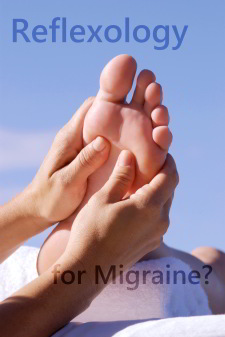Reflexology for Migraine
There are a host of alternative treatments available for migraine. One treatment, reflexology for migraine, is gaining more attention as people look outside of traditional medicine for help. But does it really help? And if so, why?
What is reflexology?

Treatment of the feet for non-foot related diseases may go back
hundreds, even thousands of years. But reflexology (usually though not
always focused on the feet) is a relatively new concept, and reflexology
for migraine is even newer.
It was in the early 1900s that
Russian neurologist and psychiatrist Vladimir Bekterev investigated how
internal systems respond to outside stimuli. US doctor William
Fitzgerald and his colleague Dr. Joe Shelby Riley also investigated zone
therapy for treating pain.
But it was really physiotherapist Eunice Ingham that developed and popularized reflexology through the 30s, 40s and 50s.
The
basic idea is that certain zones on the body (ie the feet) can be used
to influence and improve the functioning of the nervous system and
organs in the body. Ingham developed her theory by testing hundreds of
patients and developing charts of these zones.
Reflexology usually focuses on the feet, but sometimes the head, hands, and even ears.
Reflexology for Migraine
Reflexology has a long history of pain treatment, and so has been
tried for various types of headaches. Migraine is more complex that a
simple headache, or simply pain. However, since reflexology attempts to
treat the body and not the symptoms, some are enthusiastic about it's
value for migraine, both as a preventative and abortive treatment.
In
theory, helpful treatment for migraine may focus on the toes (brain,
sinuses, head) and perhaps other areas for the general functionality of
the body (stomach, lungs, etc). Similar zones would be used on the
hands. (a sample reflexology foot chart)
Reflexology - a lack of information?
Although reflexology has become a common term, we have less information
than you might think regarding how effective it is, especially when it
comes to reflexology for migraine. Part of the problem is the failure
to compare reflexology to massage and mayofacial trigger point therapy,
for example. How effective is it as compared the acupressure? Self
foot massage? We need more answers.
Perhaps the best known study of
reflexology for migraine was done in the mid-90s in Denmark. 220
patients were in the trial, and 16% saw drastic improvement of their
symptoms. 65% believed that reflexology had been some help.
There
are a few problems with this study, however. For one, it's very
unspecific. How much improvement was there? Also, the study was for
those with migraine and tension type headaches, and you have to wonder
exactly who had what and who was helped the most. Also, and this might be the key problem - how would a
simple self foot massage compare?
More information on reflexology for migraine studies.
Studies on reflexology have been mixed. Read here, for example, about a study that showed foot massage to be better than reflexology for one set of patients.
In the end, any foot massage may help. In fact, maybe it's better to buy a quality foot roller than to shell out the bucks for many treatments of reflexology.
Is it worth it?
Reflexology suffers from a lack of standardization, and a lack of study. There's good evidence that reflexology may help
with pain, and also that it may help with relaxation and body
functioning. An improvement in sleep alone may make reflexology worth
it for migraineurs. But we don't see convincing evidence that it's
better than other types of massage.
It would be helpful to see more
studies comparing reflexology with a placebo - in other words, with
other types of foot massage - for migraine. Meanwhile, it seems that foot massage in general is a very good idea for migraineurs.
It's
good to see more interest in whole body natural treatments for
migraine. Massage is excellent treatment, as is treating of pressure
points. Reflexology may help people suffering from migraine, but it's
not the first place most migraineurs will choose to spend their money.